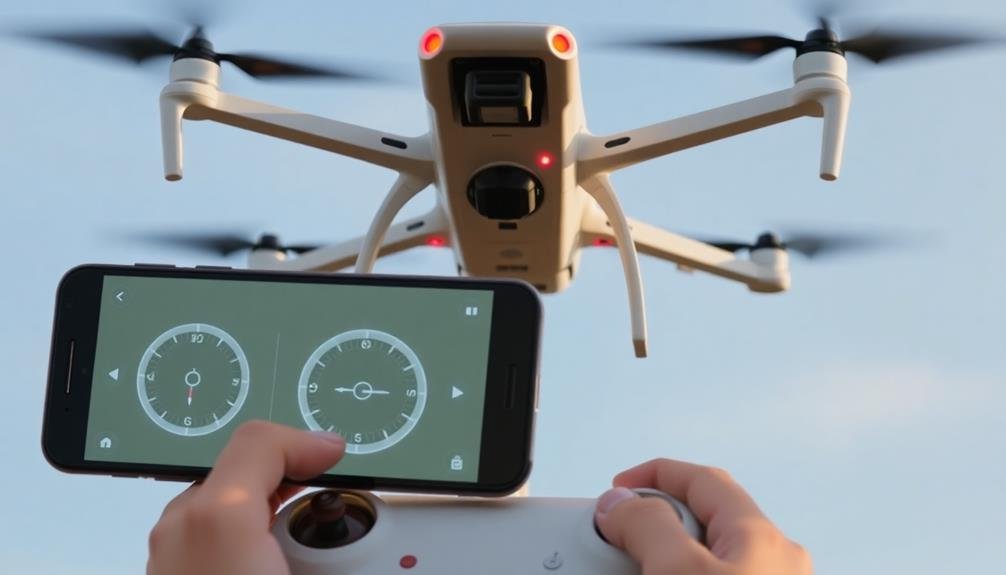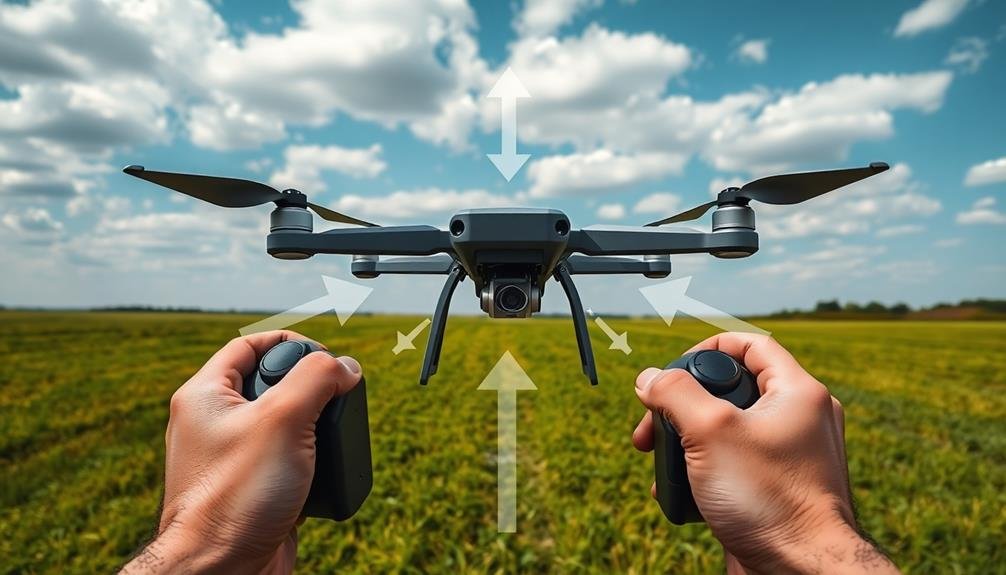As a new drone pilot, you'll need to master five essential flight controls. First, throttle control determines your altitude and vertical movement. Next, yaw allows you to rotate the drone around its vertical axis. Pitch and roll control enable forward, backward, and sideways movement. Proper drone calibration guarantees peak performance and sensor alignment. Finally, safe landing techniques are vital for protecting your investment. Start by practicing these basics in open areas with minimal obstacles. By focusing on these fundamentals, you'll build a strong foundation for more advanced maneuvers and enjoy smoother, more controlled flights. The sky's the limit as you refine these skills.
Key Takeaways
- Master throttle control for altitude management and smooth vertical movements.
- Practice yaw movements to rotate the drone and maintain orientation during flight.
- Perfect pitch and roll control for directional flying and maneuvering around obstacles.
- Perform proper drone calibration before flights to ensure optimal performance and stability.
- Learn safe landing techniques to protect your drone and surrounding environment.
Mastering Throttle Control

Throttle control is the foundation of successful drone piloting. It's the mechanism that determines your drone's altitude and vertical movement. To master throttle control, you'll need to develop a delicate touch and an intuitive understanding of how your drone responds to input.
Start by practicing hovering at a low altitude. Gently increase the throttle until your drone lifts off, then make small adjustments to maintain a steady height. Pay attention to how much throttle is needed to keep the drone in place, as this will vary depending on factors like battery level and payload.
Next, practice ascending and descending smoothly. Gradually increase the throttle to climb, and reduce it to descend. Aim for consistent, controlled movements rather than sudden jerks.
As you gain confidence, try more advanced maneuvers like rapid ascents and descents, always maintaining control.
Remember that throttle control interacts with other flight controls. Wind and momentum can affect your drone's behavior, so you'll need to compensate with throttle adjustments.
Practice in different conditions to hone your skills and develop the muscle memory needed for precise throttle control.
Understanding Yaw Movements

After mastering throttle control, you'll want to focus on yaw movements. Yaw refers to the drone's rotation around its vertical axis, allowing it to turn left or right while maintaining its altitude. It's vital for changing the direction your drone faces without altering its position.
To control yaw, you'll use the left stick on your remote controller, moving it left or right. Pushing the stick left rotates the drone counterclockwise, while pushing it right rotates it clockwise. The further you push the stick, the faster the rotation.
Yaw control is fundamental for framing shots in aerial photography, maneuvering around obstacles, and maintaining orientation during flight. Practice smooth, controlled yaw movements to avoid sudden jerks that can destabilize your drone or ruin video footage.
When learning yaw control, start with small movements and gradually increase the rotation speed. Focus on stopping the rotation precisely at desired angles. Combine yaw with other controls like pitch and roll to achieve complex flight patterns.
Remember that wind can affect yaw, so be prepared to make constant adjustments in outdoor settings.
Perfecting Pitch and Roll

With throttle and yaw under your belt, it's time to tackle pitch and roll controls. These movements are essential for maneuvering your drone in any direction.
Pitch controls the forward and backward tilt, while roll manages the left and right tilt.
To master pitch, gently push the right stick forward to tilt the drone's nose down, causing it to move forward. Pull the stick back to tilt the nose up, making the drone move backward.
Start with small, controlled movements to avoid sudden jerks or loss of altitude.
For roll, push the right stick to the left to tilt the drone leftward, and to the right for rightward movement.
Combine pitch and roll to achieve diagonal flight paths. Practice hovering in place, then slowly introduce these movements.
Calibrating Your Drone

Calibration is an essential step before every flight to confirm your drone performs at its best. It guarantees your drone's sensors are accurately aligned and functioning correctly.
Start by placing your drone on a level surface, free from magnetic interference. Most drones have a built-in calibration function in their companion app or remote control.
Begin with the compass calibration, which typically involves rotating your drone horizontally and vertically. Follow the on-screen prompts carefully, as each model may have specific instructions.
Next, calibrate the IMU (Inertial Measurement Unit) to fine-tune the drone's motion sensors. This process often requires you to keep the drone still while it collects data.
Don't forget to calibrate the gimbal, which stabilizes your camera. This usually involves gently moving the camera through its full range of motion.
Finally, check and calibrate your controller sticks to confirm they're centered and responsive. Some drones also need regular GPS calibration, especially when flying in new locations.
Practicing Safe Landing Techniques

Safe landing techniques are vital for every drone pilot to master. As you're approaching the end of your flight, it's important to bring your drone down smoothly and securely.
You'll want to practice these techniques in an open area, free from obstacles and people, until you're confident in your abilities.
Here are four key steps to guarantee a safe landing:
- Assess the landing area: Check for potential hazards like uneven terrain, power lines, or moving objects.
- Slow your descent: Gradually reduce your drone's altitude and forward speed as you approach the landing zone.
- Maintain level flight: Keep your drone parallel to the ground to avoid tipping or tilting upon touchdown.
- Use automated landing features: If your drone has them, familiarize yourself with these functions for added safety.
Frequently Asked Questions
How Do Weather Conditions Affect Drone Flight Control?
Weather conditions greatly impact your drone's flight control. Wind can affect stability and maneuverability. Rain and snow can damage electronics. Temperature extremes may affect battery life. Always check forecasts and adjust your flight plans accordingly.
What's the Best Way to Practice Drone Control in Confined Spaces?
Start with indoor simulators to hone your skills. Then, practice in open spaces before moving to confined areas. Use obstacle courses to improve precision. Always fly slowly and carefully, prioritizing safety over speed when maneuvering in tight spaces.
How Can I Improve My First-Person View (Fpv) Flying Skills?
To improve your FPV flying skills, you'll want to practice regularly in simulations, start with slower speeds, master basic maneuvers, and gradually increase difficulty. Don't forget to familiarize yourself with your drone's controls and settings.
Are There Specific Flight Control Techniques for Aerial Photography?
You'll want to master smooth, slow movements for aerial photography. Practice gentle throttle control, gradual turns, and steady ascents/descents. Use GPS mode for stability, and try pre-planned flight paths to guarantee consistent shots. Don't rush your movements.
How Do I Handle Unexpected Obstacles During Flight?
When you encounter unexpected obstacles, stay calm and take immediate action. Slow down, increase altitude if safe, and navigate around the obstacle. Always maintain visual contact and be prepared to initiate an emergency landing if necessary.
In Summary
You've now learned the essential flight controls for piloting your drone. Remember to practice throttle, yaw, pitch, and roll movements regularly. Don't forget to calibrate your drone before each flight and always prioritize safe landing techniques. As you gain confidence, you'll find yourself executing smoother maneuvers and capturing better aerial footage. Keep honing these skills, and you'll soon be flying like a pro. Happy droning!

As educators and advocates for responsible drone use, we’re committed to sharing our knowledge and expertise with aspiring aerial photographers.




Leave a Reply